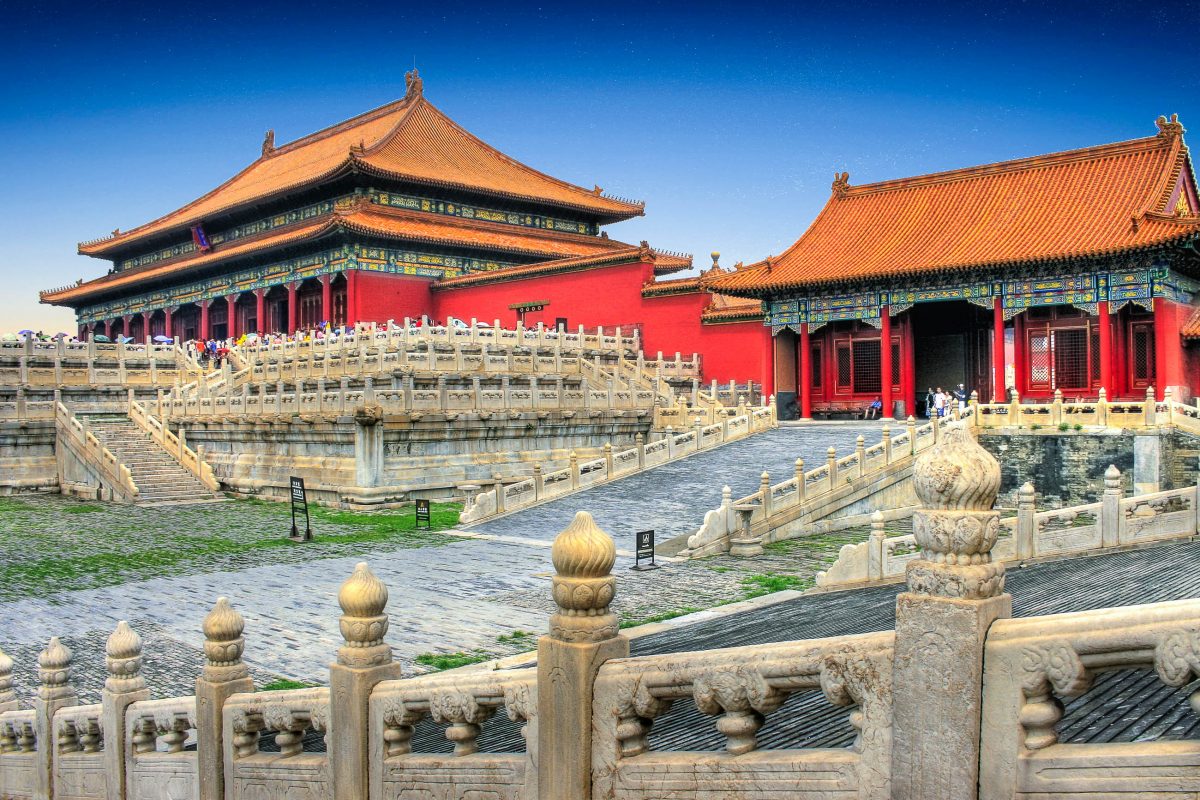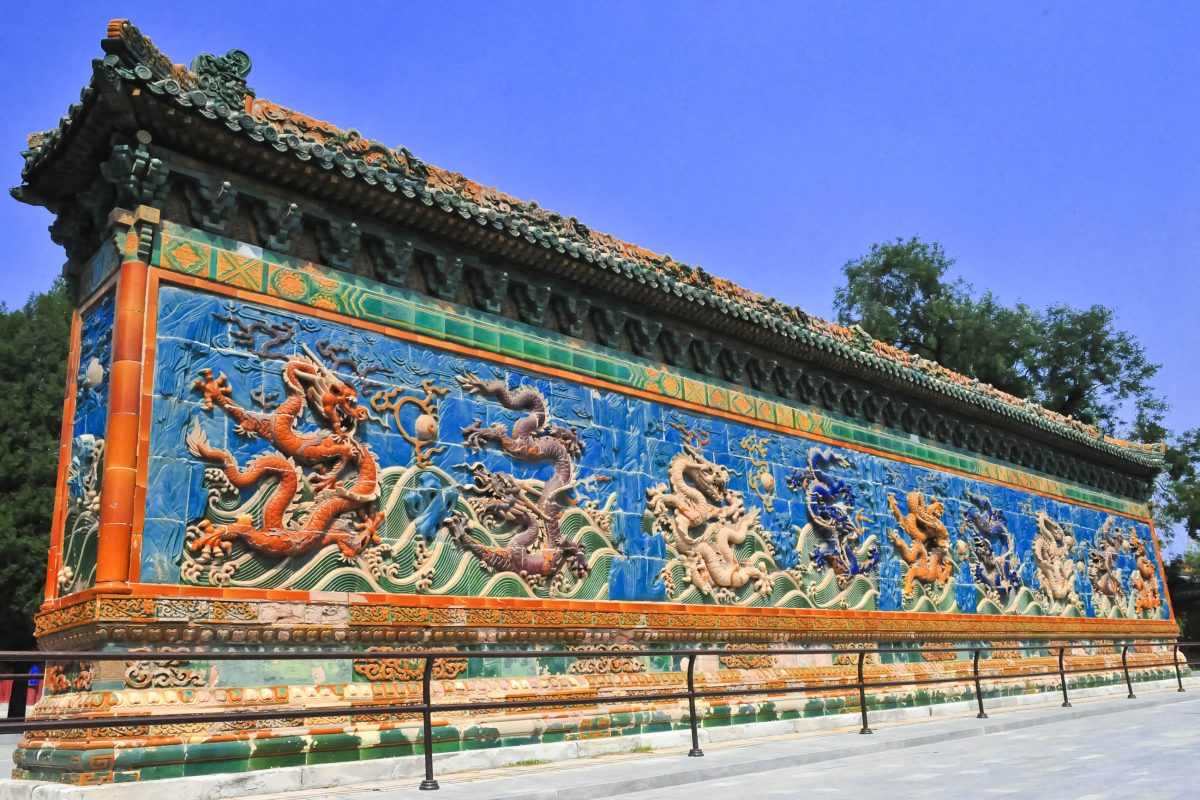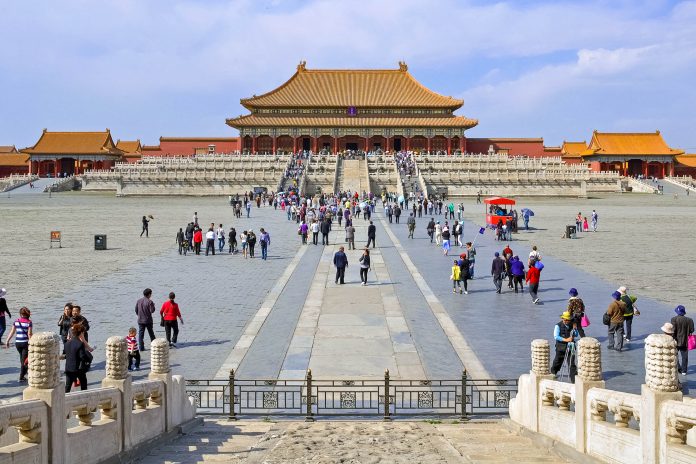Die Verbotene Stadt war als ehemaliger Kaiserpalast früher nur dem Kaiser und seinem Gefolge vorbehalten. Seit 1924 sind die prunkvollen Hallen auch für das Volk und Besucher zugänglich.
Die Verbotene Stadt (Zijincheng), wird von den meisten Chinesen als Kaiserpalast (Gugong) bezeichnet. Sie befindet sich im Zentrum der chinesischen Hauptstadt Peking am nördlichen Ende des Tian’anmen, Platz des himmlischen Friedens, und umfasst eine Fläche von etwa 720.000 Quadratmetern. Die Verbotene Stadt zählt seit 1987 zu den Weltkulturerbestätten der UNESCO und gehört auch zu unseren Top 10 Sehenswürdigkeiten von China.
Ihren Namen hat die Verbotene Stadt von der Zeit der chinesischen Kaiser vor 1924, als sich nur der Kaiser und sein Gefolge innerhalb ihrer Mauern aufhalten durften. Eingefasst wird die Verbotene Stadt von einer 10 Meter hohen Mauer und einem 52 Meter breiten Wassergraben.
Inhaltsverzeichnis
BILDER: Verbotene Stadt in Peking
Fotogalerie: Verbotene Stadt in Peking
Entstehung der Verbotenen Stadt in Peking
Erbaut wurde die Verbotene Stadt in den Jahren 1406 bis 1420 im Auftrag des dritten Kaisers der Ming-Dynastie, Yongle. Zeitweise sollen eine Million Sklaven und bis zu 10.000 Kunsthandwerker an ihrer Errichtung gearbeitet haben. Bis zur Vertreibung des letzten Kaisers lebten 24 Herrscher innerhalb von 500 Jahren in der Verbotenen Stadt und zogen von dort aus ihre Fäden der Regierung.
Die Errichtung des Kaiserpalastes folgte strengsten Regeln der allerhöchsten kaiserlichen Macht und Hierarchie-Ordnung. Die Schaltzentrale des Kaisers lag in der Mitte des Nord-Süd-ausgerichteten Schachbrettmusters, alle Dächer waren gold oder gelb lasiert und kein Gebäude der Stadt durfte höher sein als die 35m des Kaiserpalastes.
1860 besetzten britisch-französische Truppen die Verbotene Stadt im Zuge des Opium-Krieges, 1900 wurde die Kaiserinwitwe Cixi durch den Boxeraufstand aus dem Kaiserpalast vertrieben.
Fantastische Schätze der Verbotenen Stadt

Architektonische Meisterwerke und handwerkliche Schätze bietet die Verbotene Stadt am laufenden Band. Handgeschnitzte Marmor-Balustraden und Holzverzierungen gibt es egal wohin der Blick fällt. Sehenswert sind vor allem der Palast der himmlischen Klarheit mit seinem Thron, der an Prunk kaum zu überbieten ist, die Regierungshallen „Zhong He Dian“, Halle der mittleren Harmonie und „Bao He Dian“, Halle der Wahrung der Harmonie oder die Mauer der neun Drachen.
Das Tor der höchsten Harmonie ist der Eingang zur gleichnamigen Halle „Tai He Dian“ und wird von zwei bronzenen Löwenstatuen bewacht. Diese Halle enthält den Drachenthron, der genau auf der Nord-Süd-Achse platziert und zum Zeichen des Friedens von zwei Elefanten flankiert ist. Sie wird für kaiserliche Zeremonien und Feierlichkeiten, wie zum Beispiel die Krönung eines neuen Herrschers, verwendet.
Darüber hinaus gab es eigene Räumlichkeiten für diverse Bewohner und Anlässe. In den drei Palästen „Quanqinggong“ (Palast der Himmlischen Reinheit), „Jiaotaidian“ (Halle der Berührung von Himmel und Erde) und dem „Kunninggong“ (Palast der Irdischen Ruhe) lebte die Kaiserfamilie und sein Hofstaat bestehend aus hunderten Hofdamen und eigenen Palasteunuchen. Es gab eigene Räume für die Konkubinen des Kaisers, für die Kaiserin und den Kaiser wenn er seine Ruhe haben wollte (Halle zur Bildung der Gefühle) oder fastete.
Tipp: Der Extra-Eintritt für die Neun-Drachen-Mauer lohnt sich nicht wirklich, vor allem wenn man auch noch vorhat, den Beihai-Park zu besuchen, in dem ebenfalls eine (schönere) Neun-Drachen-Mauer zu sehen ist.
Besuch der Verbotenen Stadt in Peking

Heute ist die Verbotene Stadt nicht mehr verboten und ein absolutes Muss für jeden Peking-Besucher. Für die Olympischen Spiele 2008 wurde sie umfassend restauriert, die Renovierungsarbeiten wurden erst 2020 komplett abgeschlossen.
Eingangstore befinden sich in allen vier Himmelsrichtungen, das bekannteste ist das nördliche Tian’anmen, das auf den Platz des himmlischen Friedens führt. Zur Erkundung der gesamten Anlagen sollte man mindestens einen halben Tag einplanen und so früh wie möglich vor Ort sein, da die Verbotene Stadt für Touristenmassen heutzutage alles andere als verboten ist. Viele Paläste wurden zu Museen umgebaut und sind relativ überlaufen.
Orientierung in der Verbotenen Stadt

Um wirklich alle Meisterwerke zu entdecken geht man am besten systematisch in mehreren abgeschlossenen Rundgängen vor. Den besten Überblick über die Verbotene Stadt hat man vom Jingshan-Park aus, der gleich beim Hinterausgang der Verbotenen Stadt liegt. Die Hallen und Wege sind eigentlich ausreichend in englischer Sprache beschrieben, manchmal etwas knapp. Für ausführliche Hintergrundinformation empfiehlt sich ein Reiseführer.
Für Menschenscheue: Wer sich abseits der Hauptwege befindet, zum Beispiel im Kulturpalast der Werktätigen, der direkt an den Kaiserpalast angegliedert ist, wird sich wundern, wie ruhig es in der Verbotenen Stadt zugehen kann.
Kurios: Die Verbotene Stadt umfasst 9.999,5 Räume. 10.000 Räume durfte nur der Himmel besitzen und so mussten sich die Kaiser Chinas, die „Söhne des Himmels“ mit einem halben Raum weniger zufrieden geben. 10.000, „yi wan“ bedeutet übrigens auch gleichzeitig „unendlich viel“.
Weiterführende Links:
Routenvorschläge zur vollständigen Besichtigung der Verbotenen Stadt





